Open Journal of Fluid Dynamics
Vol.2 No.4(2012), Article ID:25720,10 pages DOI:10.4236/ojfd.2012.24016
Unsteady Couette Flow through a Porous Medium in a Rotating System
1Department of Applied Mathematics, Vidyasagar University, Midnapore, India
2Department of Mathematics, University of Gour Banga, English Bazar, India
Email: jana261171@yahoo.co.in
Received October 19, 2012; revised November 23, 2012; accepted December 5, 2012
Keywords: Couette Flow; Rotation Parameter; Reynolds Number; Porous Medium; Rotating System and Boundary Layer
ABSTRACT
An investigation has been made on an unsteady Couette flow of a viscous incompressible fluid through a porous medium in a rotating system. The solution of the governing equations has been obtained by the use of Laplace transform technique. It is found that the primary velocity decreases and the magnitude of the secondary velocity increases with an increase in rotation parameter. The fluid velocity components are decelerated by an increase of Reynolds number. An increase in porosity parameter leads to increase the primary velocity and the magnitude of the secondary velocity. It is also found that the solution for small time converges more rapidly than the general solution. The asymptotic behavior of the solution is analyzed for small as well as large values of rotation parameter and Reynolds number. It is observed that a thin boundary layer is formed near the moving plate of the channel and the thicknesses of the boundary layer increases with an increase in porosity parameter.
1. Introduction
The flow between two parallel plates is a classical problem that has many applications in accelerators, aerodynamic heating, electrostatic precipitation, polymer technology, petroleum industry, purification of crude oil, fluid droplets and sprays. Such a flow model is of great interest, not only for its theoretical significance, but also for its wide applications to geophysics and engineering. A lot of research work concerning the flow between two parallel plates studied in a rotating system have appeared, for example, Batchelor [1], Ganapathy [3], Gupta [4] and Mazumder [5]. The flows through porous medium are very much prevalent in nature and therefore, the study of such flows has become of principal interest in many scientific and engineering applications. This type of flows has shown their great importance in petroleum engineering to study the movements of natural gas, oil and water through the oil reservoirs; in chemical engineering for the filtration and water purification processes. Further, to study the underground water resources and seepage of water in river beds one need the knowledge of the fluid flow through porous medium. Therefore, there are number of practical uses of the fluid flow through porous media. Rotation has an immense importance in various phenomena such as in cosmical fluid dynamics, meteorology, geophysical fluid dynamics, gaseous and nuclear reactors and many engineering applications, that is why, the study of Couette flow through porous medium in a rotating system enhances an interest to the researchers due to its applications in the aforesaid area. Such a study has a greater importance in the design of turbines and turbo mechanics, in estimating the flight path of rotating wheels and spin-stabilized missiles. A large number of investigations has been made on the flow through a porous medium in a rotating system. In general, most of solutions for unsteady flows of viscous fluids are in a series form. These series may be rapidly convergent for large values of the time but slowly convergent for small values of the time or vice versa. Sometimes, it can be difficult to obtain the solution for small values of the time but it can be easy to obtain it for large values of the time and the opposite can also be true. Vidyanidhi and Nigam [6] studied the channel flow between rotating parallel plates under constant pressure gradient. Jana and Dutta [7] studied the steady Couette flow of a viscous incompressible fluid between two infinite parallel plates, one stationary and the other moving with uniform velocity, in a rotating frame of reference. Singh and Sharma [8] have presented the three dimensional Couette flow through porous media. A periodic solution of oscillatory Couette flow through a porous medium in rotating system has been obtained by Singh et al. [9]. Guria et al. [10] have described the unsteady Couette flow in a rotating system. Das et al. [10] have studied the unsteady Couette flow with an oscillatory velocity of one of the plates in a rotating system. The unsteady MHD Couette flow in a rotating system has been investigated by Das et al. [12]. Attia [13] has studied the effect of porosity on unsteady Couette flow with heat transfer in the presence of uniform suction and injection. Israel-Cookey et al. [14] have presented the MHD oscillatory Couette flow of a radiating viscous fluid in a porous medium with periodic wall temperature. The unsteady hydromagnetic Couette flow through a porous medium in a rotating system have been presented Prasad and Kumar [15]. Das et al. [16] have studied the Couette flow through porous medium in a rotating system.
In the present paper, we have studied the unsteady Couette flow between two infinite horizontal parallel plates in a porous medium in a rotating system when one of the plate moving with uniform velocity and the other one held at rest. The fluid and plates are in a state of rigid body rotation with uniform angular velocity . The solutions for the velocity distributions as well as shear stresses have been obtained for small time as well as for large time by the Laplace transform technique. It is found that the primary velocity
. The solutions for the velocity distributions as well as shear stresses have been obtained for small time as well as for large time by the Laplace transform technique. It is found that the primary velocity  decreases and the magnitude of the secondary velocity
decreases and the magnitude of the secondary velocity  increases with an increase in rotation parameter
increases with an increase in rotation parameter . The primary velocity
. The primary velocity  and the magnitude of the secondary velocity
and the magnitude of the secondary velocity  decrease with an increase in Reynolds number Re. An increase in porosity parameter
decrease with an increase in Reynolds number Re. An increase in porosity parameter  leads to increase in the values of both the primary velocity
leads to increase in the values of both the primary velocity  and the magnitude of the secondary velocity
and the magnitude of the secondary velocity . It is also found that the solution for small time converges more rapidly than the general solution. For the steady state solution, the asymptotic behavior of the solution is analysed for small as well as large values of rotation parameter
. It is also found that the solution for small time converges more rapidly than the general solution. For the steady state solution, the asymptotic behavior of the solution is analysed for small as well as large values of rotation parameter  and Reynolds number Re. It is observed that a thin boundary layer is formed near the stationary plate and the thicknesses of the boundary layer increases with an increase in porosity parameter
and Reynolds number Re. It is observed that a thin boundary layer is formed near the stationary plate and the thicknesses of the boundary layer increases with an increase in porosity parameter .
.
2. Mathematical Formulation and Its Solution
Consider the unsteady flow of a viscous incompressible fluid between two infinite parallel porous plates embedded in a porous medium. The plates are separated by a distance h. The fluid and channel rotate in unison about an axis normal to the planes of the plates with a uniform angular velocity . Choose a Cartesian co-ordinate system with x-axis along the lower stationary plate in the direction of the flow, the y-axis is normal to the plates and the z-axis perpendicular to xy-plane (see Figure 1). Flow within the channel is induced due to the motion of the upper plate at
. Choose a Cartesian co-ordinate system with x-axis along the lower stationary plate in the direction of the flow, the y-axis is normal to the plates and the z-axis perpendicular to xy-plane (see Figure 1). Flow within the channel is induced due to the motion of the upper plate at  parallel to itself in x-direction with a uniform velocity
parallel to itself in x-direction with a uniform velocity . Initially, at time
. Initially, at time , the fluid as well as the plates of the channel are assumed to be at rest. At time
, the fluid as well as the plates of the channel are assumed to be at rest. At time  the upper plate at
the upper plate at  starts moving with uniform velocity
starts moving with uniform velocity  along x-direction in its own plane while the lower plate at
along x-direction in its own plane while the lower plate at  is kept fixed. The velocity components are
is kept fixed. The velocity components are  relative to a frame of reference rotating with the fluid. Since plates of the channel are infinitely long along x and y directions, all physical quantities will be functions of z and t only.
relative to a frame of reference rotating with the fluid. Since plates of the channel are infinitely long along x and y directions, all physical quantities will be functions of z and t only.
The equation of continuity gives 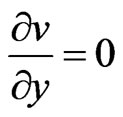 which on integration yields
which on integration yields , where
, where  for suction and
for suction and  for the blowing at the plate.
for the blowing at the plate.
The x-, yand z-components of Navier-Stokes equation are
 (1)
(1)
 (2)
(2)
 (3)
(3)
where  and
and  are respectively the fluid density, the kinematic viscosity and
are respectively the fluid density, the kinematic viscosity and  the permeability of the porous medium.
the permeability of the porous medium.
The initial and boundary conditions are
 (4)
(4)
Introducing the non-dimensional variables
 (5)
(5)

Figure 1. Geometry of the problem.
Equations (1) and (3) become
 (6)
(6)
 (7)
(7)
where  is the rotation parameter and
is the rotation parameter and 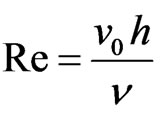 the Reynolds number and
the Reynolds number and 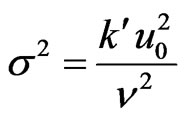 the porosity parameter.
the porosity parameter.
Combing Equations (6) and (7), we have
 (8)
(8)
where
 (9)
(9)
The initial and boundary conditions for  are
are
 (10)
(10)
 (11)
(11)
Taking the Laplace transform, Equation (8) becomes
 (12)
(12)
where
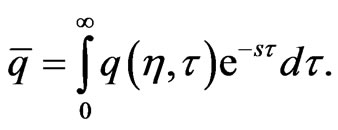 (13)
(13)
The boundary conditions for  are
are
 (14)
(14)
The solution of Equation (12) subject to the boundary conditions (14) is
 (15)
(15)
where
 (16)
(16)
The inverse Laplace’s transform of Equation (15) is
 (17)
(17)
where
 (18)
(18)
On separating into a real and imaginary parts, we get
 (19)
(19)
 (20)
(20)
where
 (21)
(21)
The solution given by Equations (19) and (20) exists for both Re < 0 (corresponding to  for the blowing at the plates) and Re > 0 (corresponding to
for the blowing at the plates) and Re > 0 (corresponding to  for the suction at the plates).
for the suction at the plates).
Solutions for Small Time
Following Carslaw and Jaegar [17], for small time, the solution of (12) subject to the boundary conditions (14) is obtained by Laplace transform technique in the following form
 (22)
(22)
where



The solution (22) can be written as
 (23)
(23)
where
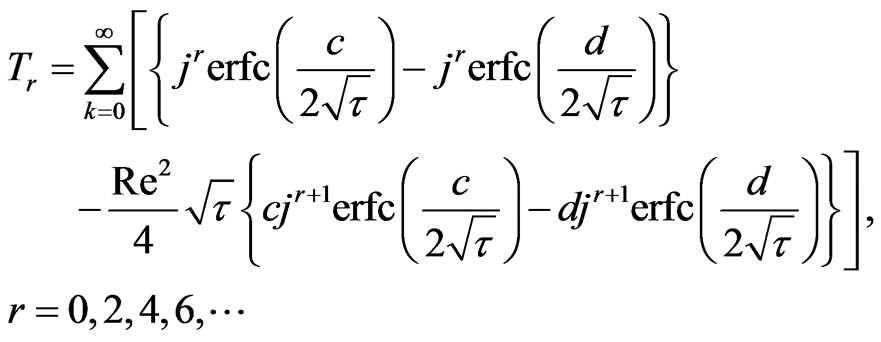 (24)
(24)
On separating into a real and imaginary parts, we get the velocity distributions for the primary and the secondary flow as
 (25)
(25)
 (26)
(26)
where
 (27)
(27)
Equations (25) and (26) describe the fluid velocities for small time.
3. Results and Discussion
To study the effects of rotation, Reynolds number and porosity parameter on the velocity distributions we have presented the non-dimensional velocity components  and
and  against
against  in Figures 2-6 for several values of the rotation parameter
in Figures 2-6 for several values of the rotation parameter , Reynolds number Re, porosity parameter
, Reynolds number Re, porosity parameter  and time
and time . It is seen from Figure 2 that the primary velocity
. It is seen from Figure 2 that the primary velocity  decreases and the magnitude of the secondary velocity
decreases and the magnitude of the secondary velocity  increases with an increase in rotation number
increases with an increase in rotation number . Figure 3 reveals that both the primary velocity
. Figure 3 reveals that both the primary velocity  and the magnitude of the secondary velocity
and the magnitude of the secondary velocity  decreases with increase in Reynolds number Re. It is observed from Figure 4 that both the primary velocity
decreases with increase in Reynolds number Re. It is observed from Figure 4 that both the primary velocity  and the magnitude of the secondary velocity
and the magnitude of the secondary velocity  increase with an increase in porosity parameter
increase with an increase in porosity parameter . The presence of porous medium produces a resisting force in the flow field. So, the resistance in the
. The presence of porous medium produces a resisting force in the flow field. So, the resistance in the
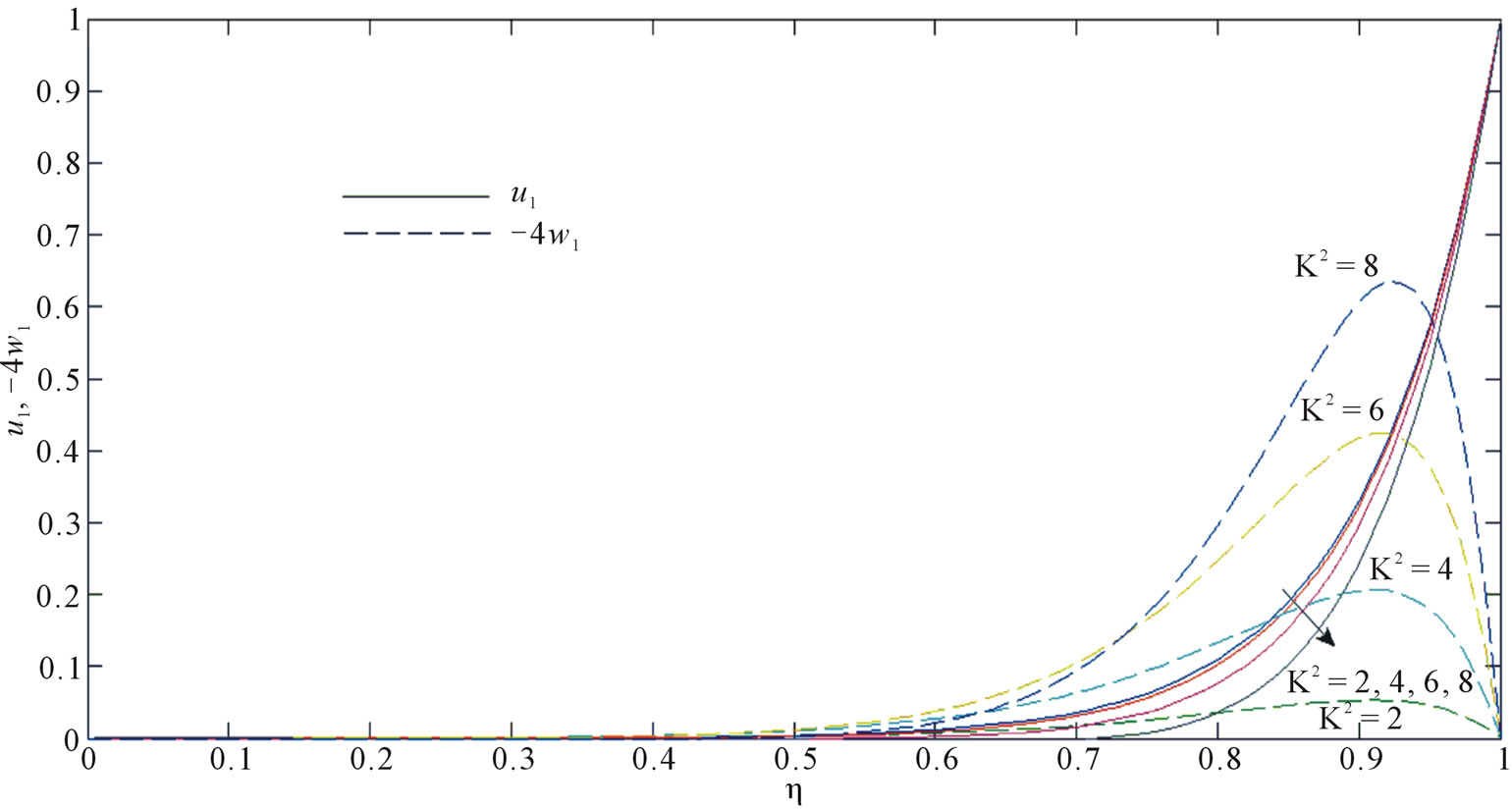
Figure 2. Velocities u1 and w1 for different K2 when Re = 2, σ = 0.1 and τ = 0.2.
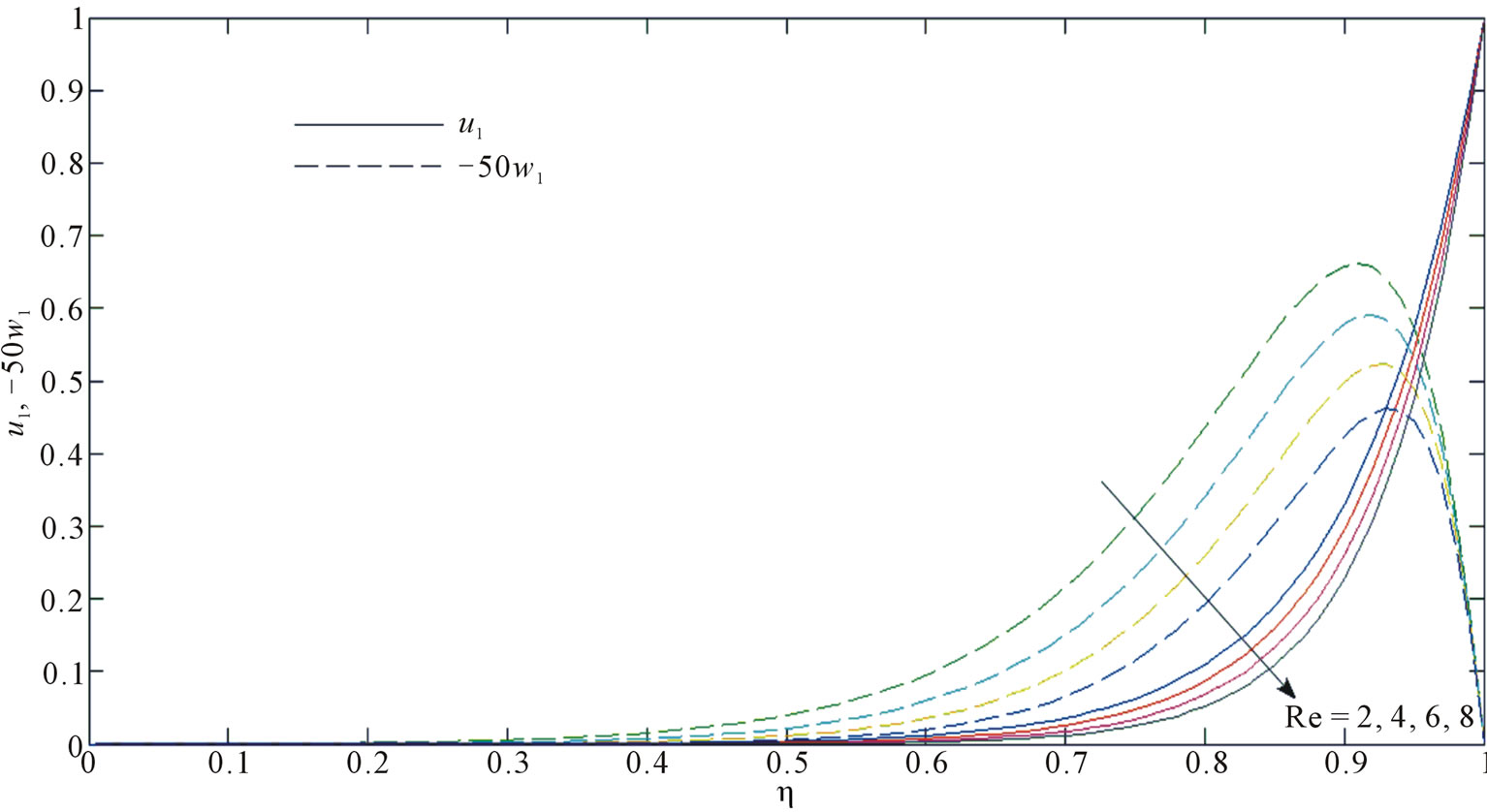
Figure 3. Velocities u1 and w1 for different Re only when K2 = 2, σ = 0.1 and τ = 0.2.
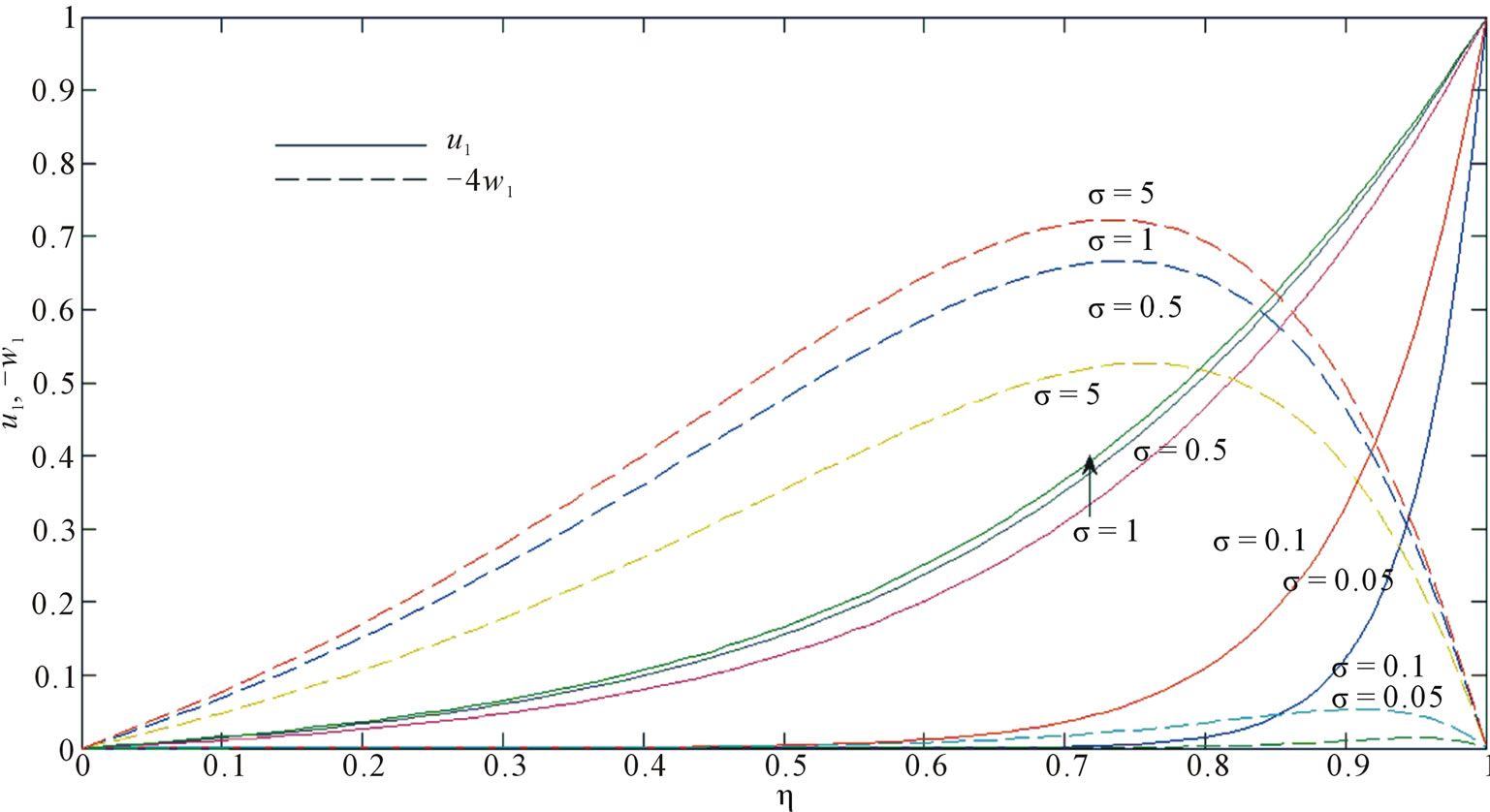
Figure 4. Velocities u1 and w1 for different σ when K2 = 2, Re = 2 and τ = 0.2.
flow field decreases as the porosity parameter  increases. This indicates that porosity of the medium has an accelerating influence on the flow field. Thus we can control the velocity field by introducing porous medium in a rotating system. It is observed from Figure 5 that both the primary velocity
increases. This indicates that porosity of the medium has an accelerating influence on the flow field. Thus we can control the velocity field by introducing porous medium in a rotating system. It is observed from Figure 5 that both the primary velocity  and the magnitude of the secondary velocity
and the magnitude of the secondary velocity  increases with an increase in times
increases with an increase in times . For small values of time, we have drawn the velocity components
. For small values of time, we have drawn the velocity components  and
and  on using the solution given by Equations (25) and (26) and the general solution given by Equations (19) and (20) in Figures 6 and 7. It is seen that the solution for small time given by Equations (25) and (26) converges more rapidly than the general solution given by (19) and (20). Hence, we conclude that for small times, the numerical values of the velocity components can be evaluated from Equations (25) and (26) instead of Equations (19) and (20).
on using the solution given by Equations (25) and (26) and the general solution given by Equations (19) and (20) in Figures 6 and 7. It is seen that the solution for small time given by Equations (25) and (26) converges more rapidly than the general solution given by (19) and (20). Hence, we conclude that for small times, the numerical values of the velocity components can be evaluated from Equations (25) and (26) instead of Equations (19) and (20).
The non-dimensional shear stresses at the stationary plate  due to the primary and the secondary flows are given by
due to the primary and the secondary flows are given by
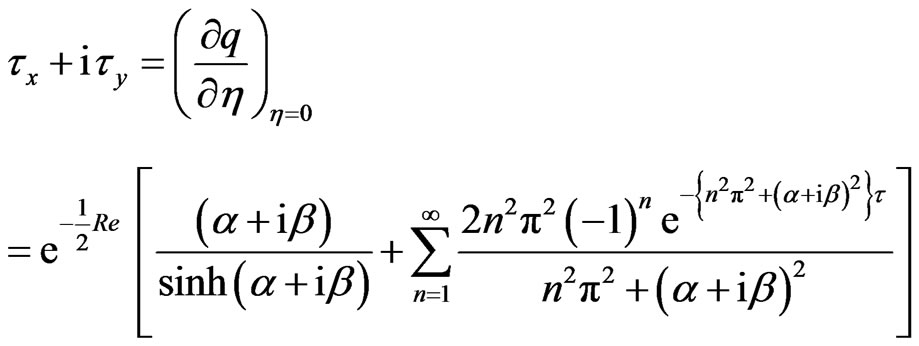 (28)
(28)
On separating into a real and imaginary parts, we get the shear stress components due to the primary and secondary flows at the stationary plate  as
as
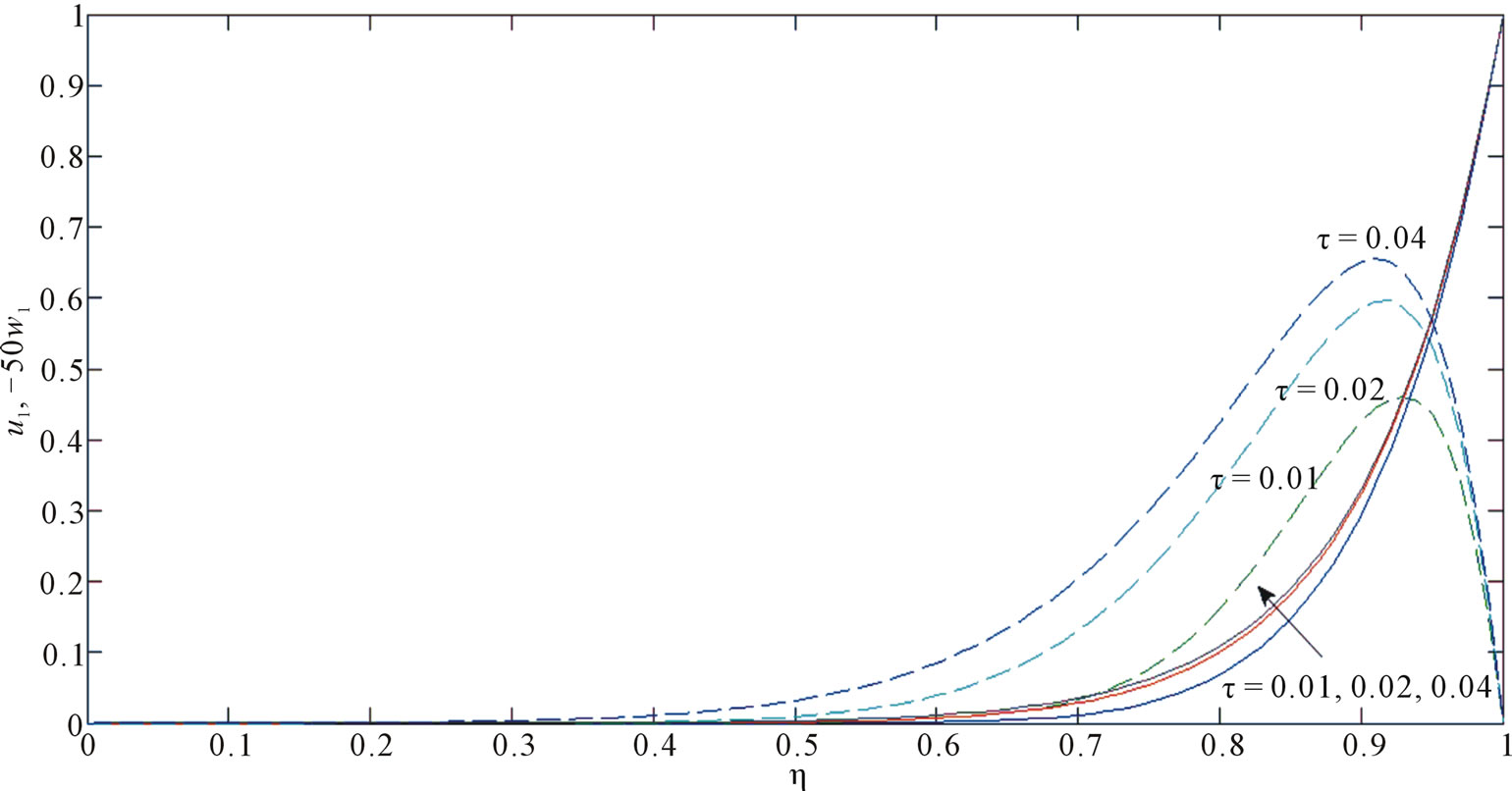
Figure 5. Velocities u1 and w1 for different time τ when K2 = 2, Re = 2 and σ = 0.1.

Figure 6. Velocity u1 for general solution and solution for small time when K2 = 2, Re = 2 and σ = 0.1.

Figure 7. Velocity w1 for general solution and solution for small time when K2 = 2, Re = 2 and σ = 0.1.
 (29)
(29)
 (30)
(30)
The numerical values of the non-dimensional shear stresses  and
and  at the plate
at the plate  are presented in Figures 8-10 against Reynolds number Re for several values of
are presented in Figures 8-10 against Reynolds number Re for several values of ,
,  and
and . It is seen from Figure 8 that both the absolute value of the shear stresses
. It is seen from Figure 8 that both the absolute value of the shear stresses  and
and  increase with increase in rotation parameter
increase with increase in rotation parameter  while the absolute value of the shear stresses
while the absolute value of the shear stresses  increases and that of the shear stress
increases and that of the shear stress  decreases with an increase in Re. Reynolds number
decreases with an increase in Re. Reynolds number  is the ratio of inertial forces to viscous forces and quantifies the relative importance of these two types of forces for given flow conditions. The viscous forces are dominant at low Reynolds numbers while the inertial forces are dominant at high Reynolds numbers. It is a good agreement with the physical point of view. Figures 9 and 10 show that the absolute value of the shear stress
is the ratio of inertial forces to viscous forces and quantifies the relative importance of these two types of forces for given flow conditions. The viscous forces are dominant at low Reynolds numbers while the inertial forces are dominant at high Reynolds numbers. It is a good agreement with the physical point of view. Figures 9 and 10 show that the absolute value of the shear stress  increases while the absolute value of the shear stress
increases while the absolute value of the shear stress  increases with an increase in either porosity parameter
increases with an increase in either porosity parameter  or time
or time .
.
For small times, the non-dimensional shear stresses due to the primary and secondary flows at the stationary plate  are given by
are given by
 (31)
(31)
where
 (32)
(32)
On separating into a real and imaginary parts, we get the shear stress components due to the primary and secondary flows as
 (33)
(33)
 (34)
(34)
where
 (35)
(35)
For small time, the numerical values of the shear stress components calculated from Equations (29), (30), (33) and (34) are given in Tables 1 and 2 for several values of Re and . It is observed that for small time the shear stresses calculated from Equations (33) and (34) give better result than that calculated from Equations (29) and (30). Hence, we conclude for small times shear stress components should be evaluated from Equations (33) and (34) instead of Equations (29) and (30).
. It is observed that for small time the shear stresses calculated from Equations (33) and (34) give better result than that calculated from Equations (29) and (30). Hence, we conclude for small times shear stress components should be evaluated from Equations (33) and (34) instead of Equations (29) and (30).
We shall now discuss the asymptotic behavior of the solutions (25) and (26) for small and large values of  and Re, when the motion is in steady state. In the steady state
and Re, when the motion is in steady state. In the steady state , Equation (17) becomes
, Equation (17) becomes
 (36)
(36)
Case 1): When  and
and .
.
When Re is large and  is of small order of magnitude, the flow becomes boundary layer type. For the boundary layer flow near the upper plate
is of small order of magnitude, the flow becomes boundary layer type. For the boundary layer flow near the upper plate , introducing the boundary layer coordinate
, introducing the boundary layer coordinate , we obtain the velocity distributions from (36) as
, we obtain the velocity distributions from (36) as
 (37)
(37)

Figure 8. Shear stresses τx and τy for different K2 when σ = 0.1 and τ = 0.2.

Figure 9. Shear stresses τx and τy for different σ when K2 = 2 and τ = 0.2.
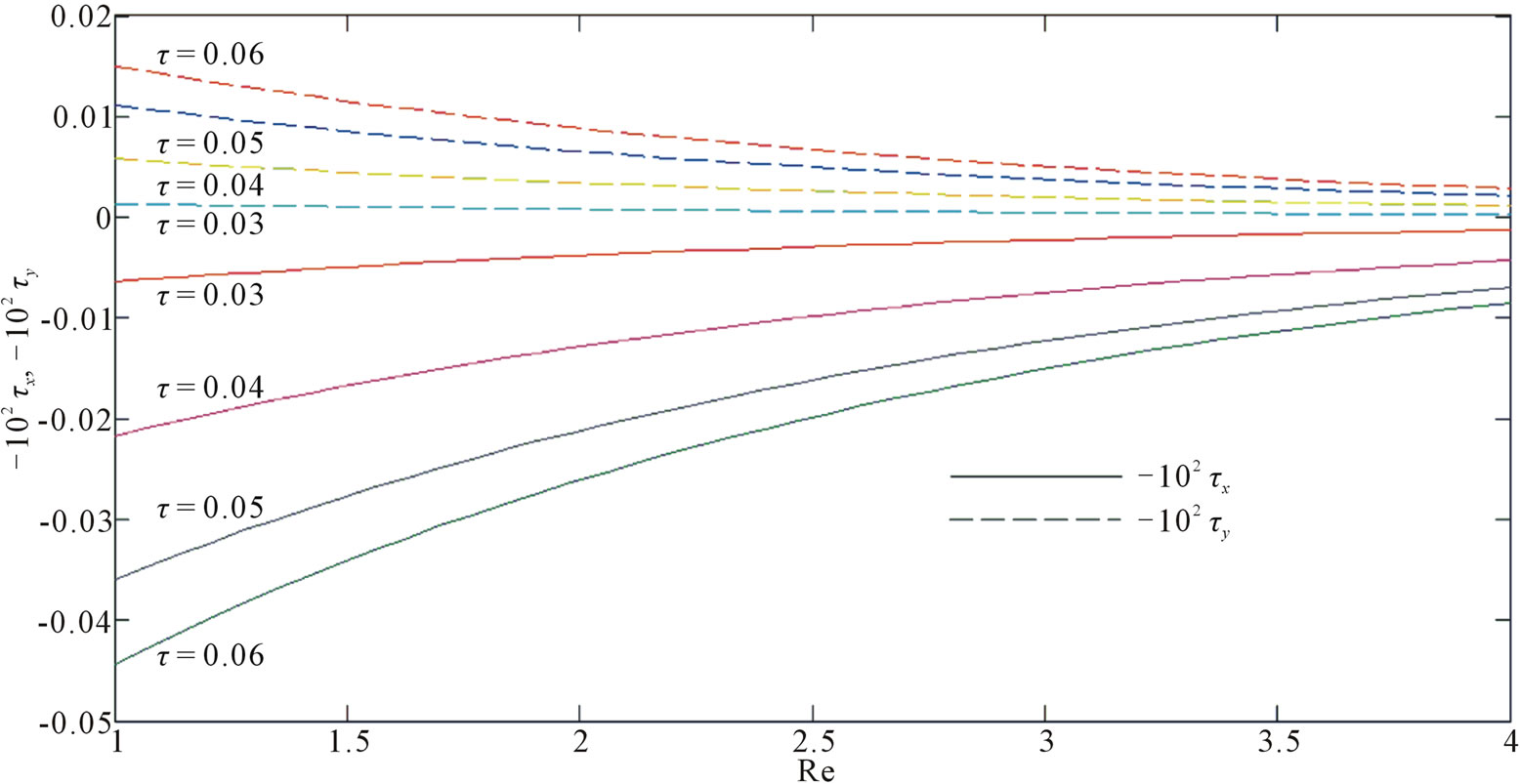
Figure 10. Shear stresses τx and τy for different τ when K2 = 2 and σ = 0.1.

Table 1. Shear stress 10τx due to primary flow when K2 = 2 and σ = 0.1.

Table 2. Shear stress −102τy due to secondary flow when K2 = 2 and σ = 0.1.
 (38)
(38)
where
 (39)
(39)
It is evident from Equations (37) and (38) that there exists a single-deck boundary layer of thickness of order
 near the moving plate of the channel where
near the moving plate of the channel where  is given by (39). The thickness of this boundary layer decreases with an increase in porosity parameter
is given by (39). The thickness of this boundary layer decreases with an increase in porosity parameter  since
since  decreases with increase in
decreases with increase in .
.
Case 2): When  and
and .
.
In this case, the velocity distributions are obtained from the Equations (36) as
 (40)
(40)
 (41)
(41)
where
 (42)
(42)
Equations (40) and (41) show that there exists a singledecker boundary layer of thickness of order
 adjacent to the moving plate of the channel where
adjacent to the moving plate of the channel where  is given by (42). The thicknesses of the layer decreases with an increase in Reynolds number Re while it increases with increase in porosity parameter
is given by (42). The thicknesses of the layer decreases with an increase in Reynolds number Re while it increases with increase in porosity parameter .
.
4. Conclusion
The unsteady Couette flow of a viscous incompressible fluid through a porous medium in a rotating system has been investigated. It is found that the primary velocity decreases and the magnitude of the secondary velocity increases with an increase in rotation parameter. The fluid velocity components decrease with an increase in Reynolds number. An increase in the porosity of the medium both the primary and the secondary velocities increase. That is, the porosity of the medium has an accelerating influence on the flow field. In turn, it can control the velocity field by introducing porous medium in a rotating system. It is also found that the solution for small time converges more rapidly than the general solution. For steady state, the asymptotic behavior of the solution is analyzed for small as well as large values of rotation parameter and Reynolds number. It is observed that a thin boundary layer is formed near the moving plate of the channel and the thicknesses of the layer increases with an increase in porosity parameter.
REFERENCES
- G. K. Batchelor, “An Introduction to Fluid Dynamics,” Cambridge University Press, Cambridge, 1967.
- G. S. Seth, R. N. Jana and M. K. Maiti, “Unsteady Hydromagnetic Couette Flow in a Rotating System,” International Journal of Engineering Science, Vol. 20, No. 9, 1982, pp. 989-999. doi:10.1016/0020-7225(82)90034-9
- R. Ganapathy, “A Note on Oscillatory Couette Flow in a Rotating System,” Journal of Applied Mechanics, Vol. 61, No. 1, 1994, pp. 208-209. doi:10.1115/1.2901403
- A. S. Gupta, “Ekman Layer on a Porous Plate,” Physics of Fluids, Vol. 15, No. 5, 1972, pp. 930-931. doi:10.1063/1.1694002
- B. S. Mazumder, “An Exact Solution of Oscillatory Couette Flow in a Rotating System,” Journal of Applied Mechanics, Vol. 56, No. 4, 1991, pp. 1104-1107. doi:10.1115/1.2897694
- V. Vidyanidhi and S. D. Nigam, “Couette Flow between Rotating Parallel Plates under Constant Pressure Gradient,” Journal of Mathematical Physics, Vol. 1, 1967, pp. 85.
- R. N. Jana and N. Dutta, “Couette Flow and Heat Transfer in a Rotating System,” Acta Mechanica, Vol. 26, No. 1-4, 1977, pp. 301-306. doi:10.1007/BF01177152
- K. D. Singh and R. Sharma, “Three Dimensional Couette Flow through Porous Media,” Indian Journal of Pure and Applied Mathematics, Vol. 32, No. 12, 2001, pp. 1819- 1829.
- K. D. Singh, M. G. Gorla and H. Rajhans, “A Periodic Solution of Oscillatory Couette Flow through a Porous Medium in Rotating System,” Indian Journal of Pure and Applied Mathematics, Vol. 36, No. 3, 2005, pp. 151-159.
- M. Guria, R. N. Jana and S. K. Ghosh, “Unsteady Couette Flow in a Rotating System,” International Journal of Non-Linear Mechanics, Vol. 41, No. 6-7, 2006, pp. 838- 843. doi:10.1016/j.ijnonlinmec.2006.04.010
- B. K. Das, M. Guria and R. N. Jana, “Unsteady Couette Flow in a Rotating System,” Meccanica, Vol. 43, No. 5, 2008, pp. 517-521. doi:10.1007/s11012-008-9130-x
- S. Das, S. L. Maji, M. Guria and R. N. Jana, “Unsteady MHD Couette Flow in a Rotating System,” Mathematical and Computer Modelling, Vol. 50, No. 7-8, 2009, pp. 1211-1217.doi:10.1016/j.mcm.2009.05.036
- H. A. Attia, “Effect of Porosity on Unsteady Couette Flow with Heat Transfer in the Presence of Uniform Suction and Injection,” Kragujevac Journal of Science, Vol. 31, No. 1, 2009, pp. 11-16.
- C. Israel-Cookey, E. Amos and C. Nwaigwe, “MHD Oscillatory Couette Flow of a Radiating Viscous Fluid in a Porous Medium with Periodic Wall Temperature,” American Journal of Scientific and Industrial Research, Vol. 1, No. 2, 2010, pp. 326-331.
- B. G. Prasad and R. Kumar, “Unsteady Hydromagnetic Couette Flow through a Porous Medium in a Rotating System,” Theoretical and Applied Mechanics Letters, Vol. 1, No. 4, 2011, Article ID: 042005. doi:10.1063/2.1104205
- S. Das, M. Jana and R. N. Jana, “Couette Flow through Porous Medium in a Rotating System,” International Journal of Mathematical Archive, Vol. 2, No. 11, 2011, pp. 2318-2326.
- H. S. Carslaw and J. C. Jaeger, “Conduction of Heat in Solids,” Oxford University Press, Oxford, 1959, p. 297.

